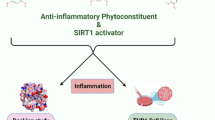Abstract
In this paper, curcumin, demethoxycurcumin, bisdemethoxycurcumin and another curcum in derivative are investigated for their inhibitory effects on nonenzymatic glucosylation in vitro, their binding reaction with bovine serum albumin (BSA) and their influence on the conformational changes of BSA. It demonstrated that all of these curcumin derivatives inhibited the formation of advanced glycation end products (AGE). Curcumin showed the most potent inhibitory activity, followed by demethoxycurcumin and bisdemethoxycurcumin. Moreover, it indicated that they extensively binded to the protein and induced the conformational changes of BSA.
Similar content being viewed by others
References
Hongw K. and Spornm B., Recent advances in chemoprevention of cancer, Science, 1997, 278: 1073–1077
Metz T. O., Alderson N. L. and Thorpe S. R., Pyridoxamine, an inhibitor of advanced glycation and lipoxidation reactions: a novel therapy for treatment of diabetic complications, Arch. Biochem. Biophys., 2003, 419: 41–49
Bierhaus A., Hofmann M. A. and Ziegler R., AGEs and their interaction with AGE-receptors in vascular disease and diabetes mellitus. I The AGE concept, Cardiovasc. Res., 1998, 37: 586–600
Park S. Y. and Kim D. S., Discovery of natural products from Curcuma longa tha protects cells from beta-amyloid inset: a drug discovery effort against Alzheimer’s disease, J. Nat. Pro., 2002, 65(9): 1227–1231
Kim J. H. and Kwon H. J., Novel curcumin derivatives. WO03105751
Sun Y. X., Hayakawa S. and Izuemori K., Modification of ovalbumin with a rare ketohexose through the Millard Reaction: effect on protein structure and gel properties, J. Agric. Food Chem., 2004, 52: 1293–1299
Feng X., Bai C., Lin Z. et al., The interaction between acridine orange and bovine serum albumin, Chin. J. Anal. Chem., 1998, 26(2): 154
Mao P., Zhang J. and Huang Q., Blocking effect of quercetin on the nonenzymatic glucosylation of aortic collagen, Chin. J. Diabetes, 1998, 6(1): 34–37
Sua Rezl G. and Wang X. H., Differential inhibition of maillard protein fluorescence by nitric oxide donors, J. Biol. Chem., 1998, 2(6): 475–480
Sharma O. P., Antioxidant activity of curcumin and related compounds, Biochem. Pharmacol., 1976, 25: 1181–1812
Shahed A. R., Jones E. and Shokes D., Quercentin and curcumin up-regulate antioxidant gene expression in rat kidney after urethral obstruction or ischemia reperfusion injury, Transplant Proc., 2001, 33(6): 2988
Author information
Authors and Affiliations
Corresponding author
Additional information
__________
Translated from Zhong shan Daxue Xue bao/Acta Scientiarum Natralium University Sunyatseni, 2005, 44(3)(in Chinese)
About this article
Cite this article
Li, M., Liu, Z., Zhang, Z. et al. Inhibitory effects of curcumin derivatives on nonenzymatic glucosylation in vitro . Front. Chem. China 1, 227–231 (2006). https://doi.org/10.1007/s11458-006-0012-2
Issue Date:
DOI: https://doi.org/10.1007/s11458-006-0012-2




